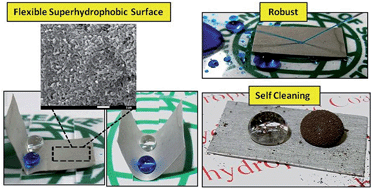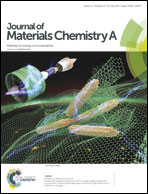A mechanically bendable superhydrophobic steel surface with self-cleaning and corrosion-resistant properties†
Abstract
We present an effective way to develop superhydrophobic steel surface which shows stable superhydrophobicity under harsh mechanical bending. The roughness on the steel surface was created by etching in acid solution and its surface energy was lowered by subsequent hydrophobic silane treatment. The steel etching time in sulfuric acid solution was optimized to 8 h which provides high surface roughness required for superhydrophobicity. A water contact angle of 164 ± 3° and a sliding angle of 9 ± 2° were obtained for the steel surface after surface chemical modification by methyltrichlorosilane. We bent this superhydrophobic steel to 90° and 180° and studied the wetting properties on the bent area, which showed absolutely no change in superhydrophobicity. This superhydrophobic steel surface showed excellent self-cleaning behaviour as well as maintained its superhydrophobic wetting properties under a stream of water jet. Further, the stability of the wetting state was evaluated using a sandpaper abrasion test, adhesive tape peeling test, and under prolonged UV irradiation. Energy-dispersive X-ray spectroscopy was used to confirm the surface chemical composition of the superhydrophobic steel surface. This approach can be applied to steel surfaces of any size and shape to advance their industrial applications.


 Please wait while we load your content...
Please wait while we load your content...